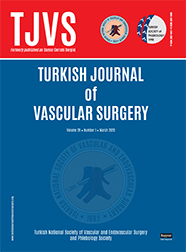
The Turkish Journal of Vascular Surgery
Yazarlar: Ali Haydar BAYKAN, Ali Ümit YENER, Kemal KORKMAZ, Bülent Çağlar BİLGİN, Umut Hasan KANTARCI, Mustafa KARAÇELİK, Turgut KARACA, Hikmet Selçuk GEDİK
Konular:-
Anahtar Kelimeler:Wells score; Doppler ultrasound; DVT
Özet: Objective: Acute deep vein thrombosis (DVT) is a serious and frequent health problem that affects many people in the world. The purpose of this study is to compare Doppler ultrasound data and Wells scoring, which is the most widely known and used risk score, for detection of low and high risk patients for DVT. Material and Methods: Wells scores and Doppler ultrasound results of 85 women and 64 men with the diagnosis of acute DVT were retrospectively analyzed. There were 149 patients in total who were between 22 and 88 years of age. Patients with complaints more than one week and patients who had the diagnosis of DVT and under follow-up were excluded from the study. Doppler ultrasound and Wells scoring of patients were performed in the same day. The assessed prevalence of DVT in patients with each method were calculated, when Doppler ultrasound data was taken as a gold standard, then the sensitivity and specificity of Wells scoring values were calculated. Score thresholds were used while calculating these values. Results: DVT was detected with above-knee examination of Doppler ultrasound in 75 out of 149 pa- tients who were included in this study. According to this, in patients pre diagnosed with DVT in the De- partment of Cardiovascular Surgery Clinic, the prevalence was 50.3%. The sensitivity and specificity of high risk score for predicting DVT were 61.3% and 60.8%, respectively. The same values were 92% and 43.2% for high-moderate risk scores. When of high probability (score ≥ 2) and low probability (score <2) scores were dichotomized, sensitivity and specificity were 81.3% and 55.4%, respectively. Conclusion: Only Wells scoring may not be an effective method while predicting of thromboembolic cases and it can be said that it does not impose an additional advantage on selection of the clinicians. However, it might be more useful to investigate the effectiveness of Wells scoring in an algorithm. To test this approach, the tests such as D-dimer test and Doppler ultrasound, should be investigated in the context of the algorithm while tak- ing the costs into consideration.